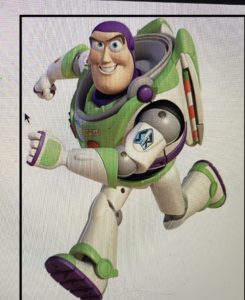Buzz Lightyear and the Plot to Destroy America

Yesterday, I took my granddaughter (8) and grandson (5) to see the new Disney Pixar movie Lightyear. Since I don’t have little kids and didn’t see any of the original Toy Story franchise movies, I really didn’t know what to expect. Of course, I knew that Disney had been battling with the Grand Wizard DeSantis of Florida over the “Don’t Say Gay” law, but I didn’t connect that with the movie I was about to see. I expected the usual heavy dose of the triumph of good over evil, of righteousness upheld, of moral lessons learned that kids’ movies have always dished out like paregoric to my generation, albeit with updated spins for various woke themes.
The grandkids were hunkered down, busily stuffing their faces with the candy and slurpies we’d conspired to buy behind my daughter’s back (“Don’t let them eat junk, Dad”), when onto the screen came an archetypal cartoon hero with a chin that would put Jay Leno’s to shame, a chin that told you American masculinity was going to be well-served in this tale. Enter Buzz Lightyear. I was delighted, however, to see that his boss (Izzy Hawthorne) was both African-American and a woman, though with the same doe-like eyes of other Disney heroines (not much different than my era’s Bambi). Not only were Buzz and Izzy colleagues in the fight against the cosmic evil of Emperor Zurg, they are also “best friends.” Being the astute novelist and programmed as I was to the usual ‘50’s versions of such narrative romantic dynamics, I assumed that by the end “best friends” would somehow evolve into something more. I should have known that unlike (spoiler alert) the older, evil version of Buzz, I didn’t possess the ability to time travel back to my own childhood of Sleeping Beauty or Cinderella. Neither, it seems, did the movie want to return MAGA-like back to the never-never land of the supposedly pure fifties, but rather kept its hero Buzz in the flawed but real present. In fact, that’s one of the movie’s central themes—that we can’t travel backwards but must move forward dealing with often unpleasant realities, such as failure and cowardice, hubris and eventually death but learning along the way to get along and do the right thing.
Then came the kiss.
The one that got the movie banned from most Muslim countries as well as created such a firestorm here in America in evangelical and conservative circles (Ted Cruz, at his most insightful, opined, “Most toys are, kinda, androgynous. They’re usually without genitalia.”). Right on screen, Izzy kisses her lover and partner. Yet it’s not Buzz who gets kissed (though the kiss certainly created a buzz in the right-wing universe that wants to return us to a world where gayness not only doesn’t exist, the word itself can’t even be uttered for fear of eternally damaging our children; AR15’s and poverty are fine, but evidently not chaste kisses between middle-aged partners). Rather the kiss is between Izzy and her wife. It seems that for some–though not those in the movie ironically–the “kiss” represented a disturbingly woke statement by Disney, a virtue signaling that was also intended to indoctrinate our children to become gay. However, like the younger Buzz, Izzy Hawthorne wasn’t going backwards to some supposedly safe and mythically universal past that we all shared. Instead, she’s moving forward, literally and symbolically, living and loving, raising children, being strong and kind and accepting life as it is, growing old, and finally, dying with dignity, all while the adolescent Buzz tries and fails again and again to return to a past that is gone.
When the “kiss” took place, I glanced over at my grandkids, to see how they reacted and to take note of the damage done to their fragile psyches. Both were too enthralled with the movie—and too busy eating their their candy—to care. When we left I asked what they thought of Izzy dying. They both agreed that it was sad. That’s it. For me what was sad was making such a big deal out of who we decide to kiss.